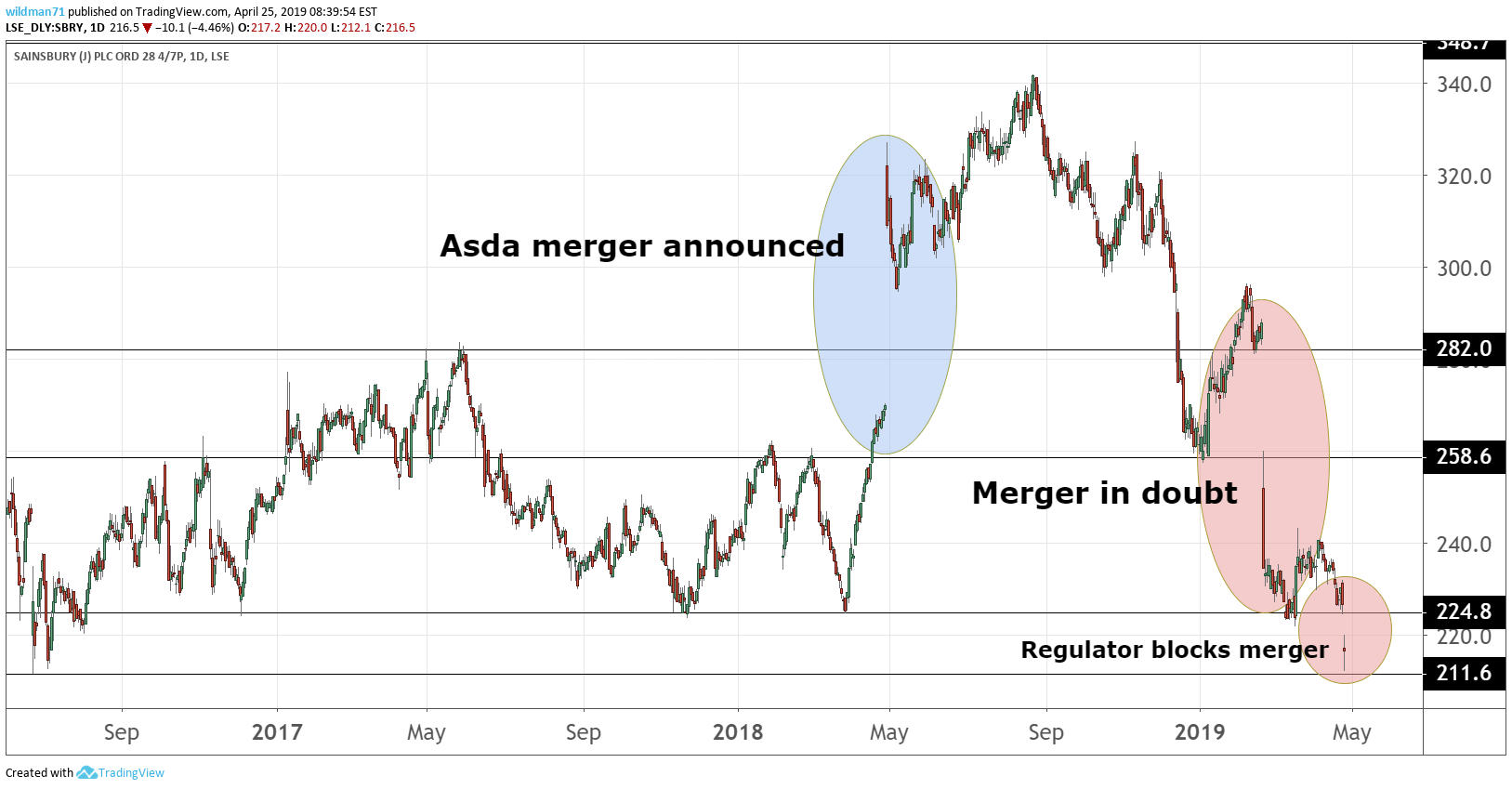
Sainsbury’s: Buyers bet that shares have seen the low
By Graeme Evans from interactive investor.
Trading within a whisker of a record low, a lot of bad news is already written into the share price.
Yesterday’s humiliation of Sainsbury (J) (LSE:SBRY) and its boss Mike Coupe has not stopped investors from piling into the supermarket giant’s shares in the belief the chain can bounce back from the competition regulator’s total rejection of a merger with Asda.
The buying interest comes after shares had earlier tumbled 6 per cent to their lowest level in almost three years, with the Competition and Markets Authority (CMA) killing off the £7.3 billion deal without even mention of possible concessions.
The FTSE 100 index stock was the most-bought on the interactive investor platform yesterday, with opportunistic investors confident a chain that still controls more than 15 per cent of the UK grocery market has plenty of levers to pull in terms of improving its performance.
They can take some comfort from the revival at Tesco (LSE:TSCO), which has transformed its fortunes under Dave Lewis following an accounting scandal in 2014. The UK’s biggest supermarket has just recorded annual profits of £2 billion after 12 quarters in a row of like-for-like sales growth.
Sainsbury’s shares, just a fraction of a penny from the record low set around the time of the EU referendum in 2016, now trade on little more than 10 times forecast earnings. That’s a big discount to rivals Tesco and Morrisons (LSE:MRW), and there’s a yield of over 4.5 per cent too.
Its organic growth prospects have been called “uninspiring” by some in the City, but there are areas which should deliver a boost to profits, not least a £500 million cost-cutting programme already underway. Relocating hundreds more Argos stores into Sainsbury’s supermarkets as leases expire could, according to UBS, be worth £100 million of operating profit.

Source: TradingView Past performance is not a guide to future performance
Whether Coupe will remain at the helm to oversee any Sainsbury’s revival is debatable. As if things weren’t bad enough following last year’s “We’re in the Money” gaffe (Coupe was caught humming the tune before a filmed interview to discuss the Asda merger plans had begun), the manner in which regulators dismantled his grand plan is hugely embarrassing for the CEO.
Investors will find out if Coupe has a “plan B” when Sainsbury’s presents annual results next Wednesday. At the very least, there should be plenty of opportunities for Coupe to drive performance now that the merger distraction is out the way.
Judging by consumer feedback, Sainsbury’s has room to improve in areas such as product availability and in terms of store appearance. It’s been losing ground to rivals in recent months, with merger partner Asda now ahead of it in the supermarket pecking order, and discounters Aldi and Lidl continuing to make inroads. Tesco and Morrisons are in fine form and there’s the added threat from online rivals such as Amazon (NASDAQ:AMZN) and Ocado (LSE:OCDO).
In fact, removing Coupe could prove to be counter-productive if a change at the top creates further uncertainty when Sainsbury’s needs to be fully focused on the competition.
Coupe announced the merger with Walmart-owned Asda just two years after completing the exhausting acquisition of Argos-owner Home Retail. In an industry where scale is everything, the new company would have generated annual revenue of around £51 billion and savings of “at least” £500 million a year.
Despite the CMA’s conclusion today that the deal would increase prices, Coupe said the rejection had effectively taken £1 billion out of customers’ pockets.
Shares jumped as much as 21 per cent when the merger plan was announced last April, with analysts at UBS thinking it could be worth an extra 27.5 per cent of earnings per share by 2022. If Asda maintained its current margin of 3.6 per cent, that figure could have reached 39 per cent.
These articles are provided for information purposes only. Occasionally, an opinion about whether to buy or sell a specific investment may be provided by third parties. The content is not intended to be a personal recommendation to buy or sell any financial instrument or product, or to adopt any investment strategy as it is not provided based on an assessment of your investing knowledge and experience, your financial situation or your investment objectives. The value of your investments, and the income derived from them, may go down as well as up. You may not get back all the money that you invest. The investments referred to in this article may not be suitable for all investors, and if in doubt, an investor should seek advice from a qualified investment adviser.
